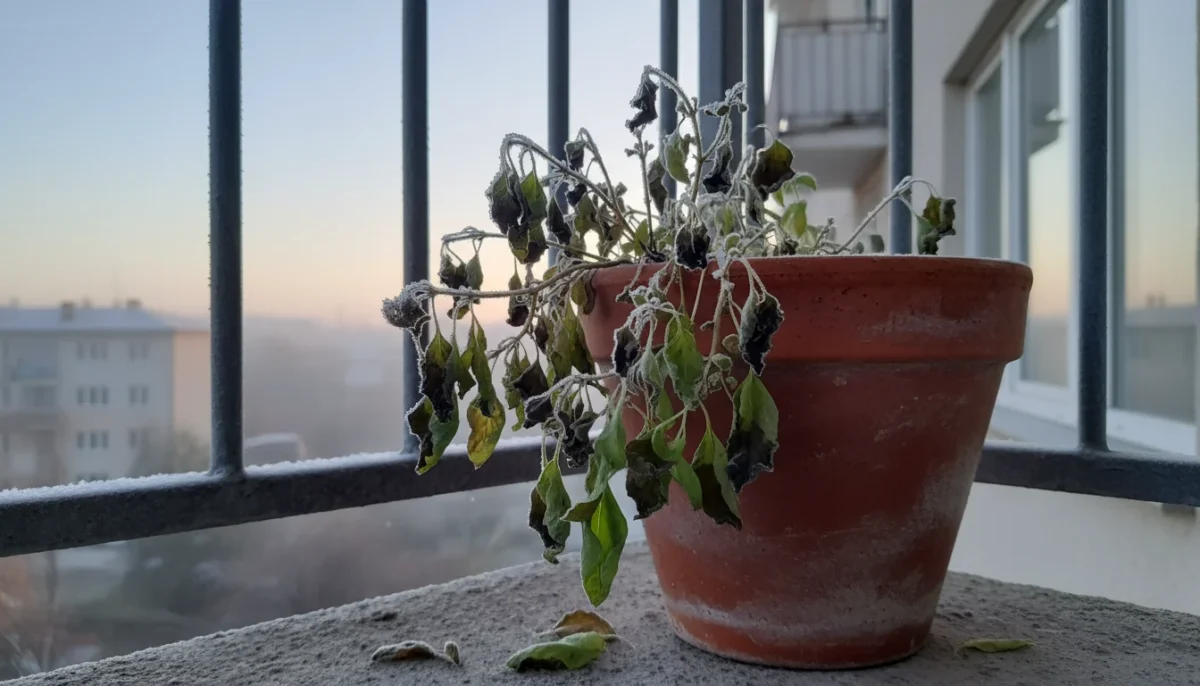As autumn arrives, a shift in the air often signals the impending first fall frost. For your balcony garden, this can feel like a sudden threat, especially when your container plants are still thriving. A single night of unexpectedly low temperatures can cause significant damage or even kill tender plants you have nurtured all season. However, with proactive steps and a clear understanding of what to expect, you can protect your cherished balcony garden. This guide provides practical, actionable insights to help you prepare your container plants for winter, ensuring their survival and your continued gardening success.
Preventing frost damage does not require a complex overhaul of your gardening routine. Instead, it involves understanding a few key principles and implementing simple, effective strategies. We will cover how to assess your plants’ vulnerability, when to act, and the best methods for shielding them from freezing temperatures. You will learn straightforward techniques for frost protection, whether that means bringing sensitive plants indoors or providing adequate outdoor cover for more resilient varieties. Our goal is to empower you to safeguard your balcony garden with confidence, turning a potential seasonal panic point into a manageable task.
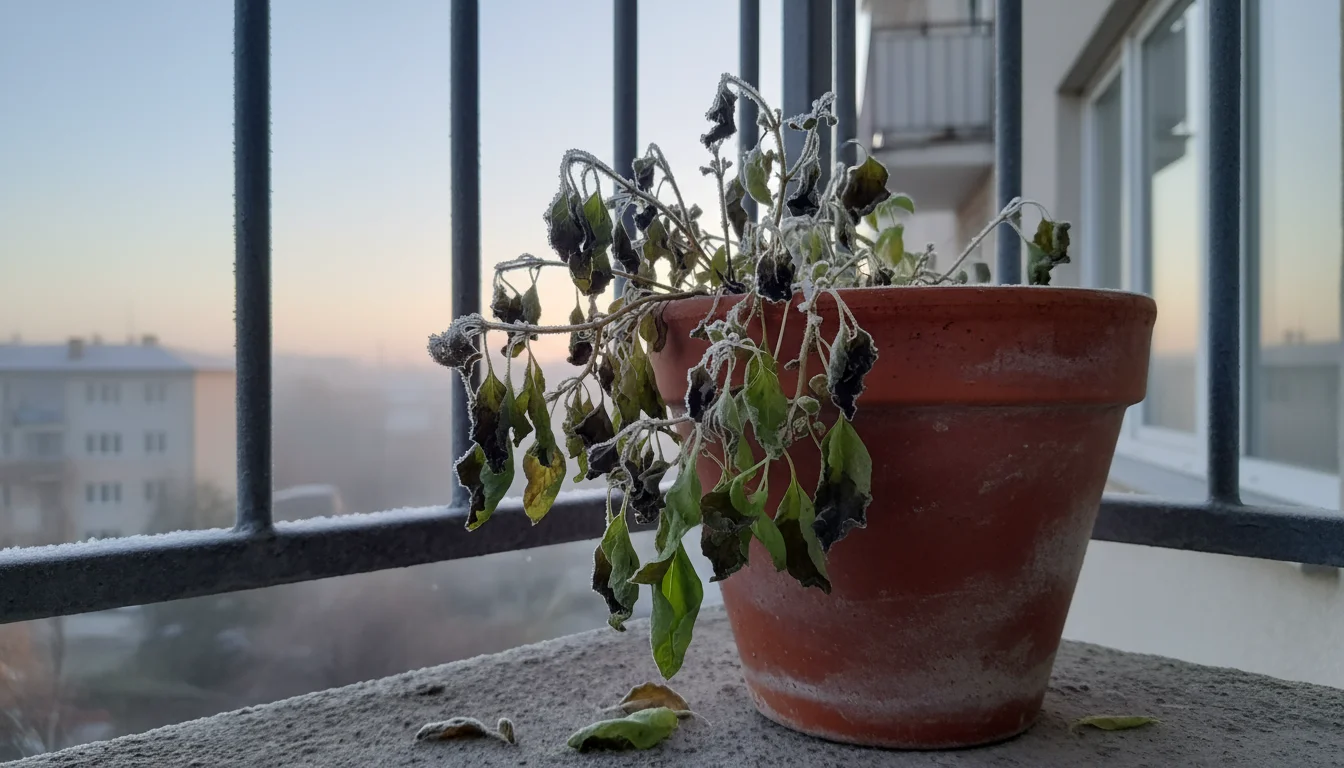
Understanding the First Fall Frost Threat
The first fall frost marks a crucial transition in the gardening season. It often arrives unexpectedly, catching many gardeners off guard. Understanding what frost is and how it impacts your container plants on a balcony helps you prepare effectively. Frost occurs when the air temperature at ground level drops to 32 degrees Fahrenheit (0 degrees Celsius) or below. Water within plant cells freezes, expands, and ruptures cell walls, leading to irreversible damage that appears as blackened, wilted foliage.
Balcony gardens face unique challenges when it comes to frost. Container plants are more susceptible to cold damage than plants in the ground. Their roots are exposed to ambient air temperatures on all sides, unlike garden beds where soil acts as an insulator. This means the soil in your pots cools down much faster and reaches freezing temperatures sooner than the surrounding ground. A temperature of 35 degrees Fahrenheit (1.7 degrees Celsius) can be too cold for container plants, particularly tender annuals and tropical perennials, if sustained for several hours or if wind chill is a factor. Your specific balcony microclimate, influenced by building shelter, sun exposure, and wind, also plays a significant role in how quickly temperatures drop and how severely your plants are affected.
A “light frost” typically sees temperatures drop just below freezing, affecting only the most sensitive plants. A “hard frost” or “killing frost” brings temperatures significantly below freezing for several hours, causing widespread damage to most non-hardy plants. You want to act well before a hard frost. Data shows that even a few hours at 28-32 degrees Fahrenheit (minus 2 to 0 degrees Celsius) can prove fatal for many common balcony plants like impatiens, petunias, and basil. Observing local weather patterns and paying close attention to forecasts becomes your most powerful tool in protecting your balcony garden.
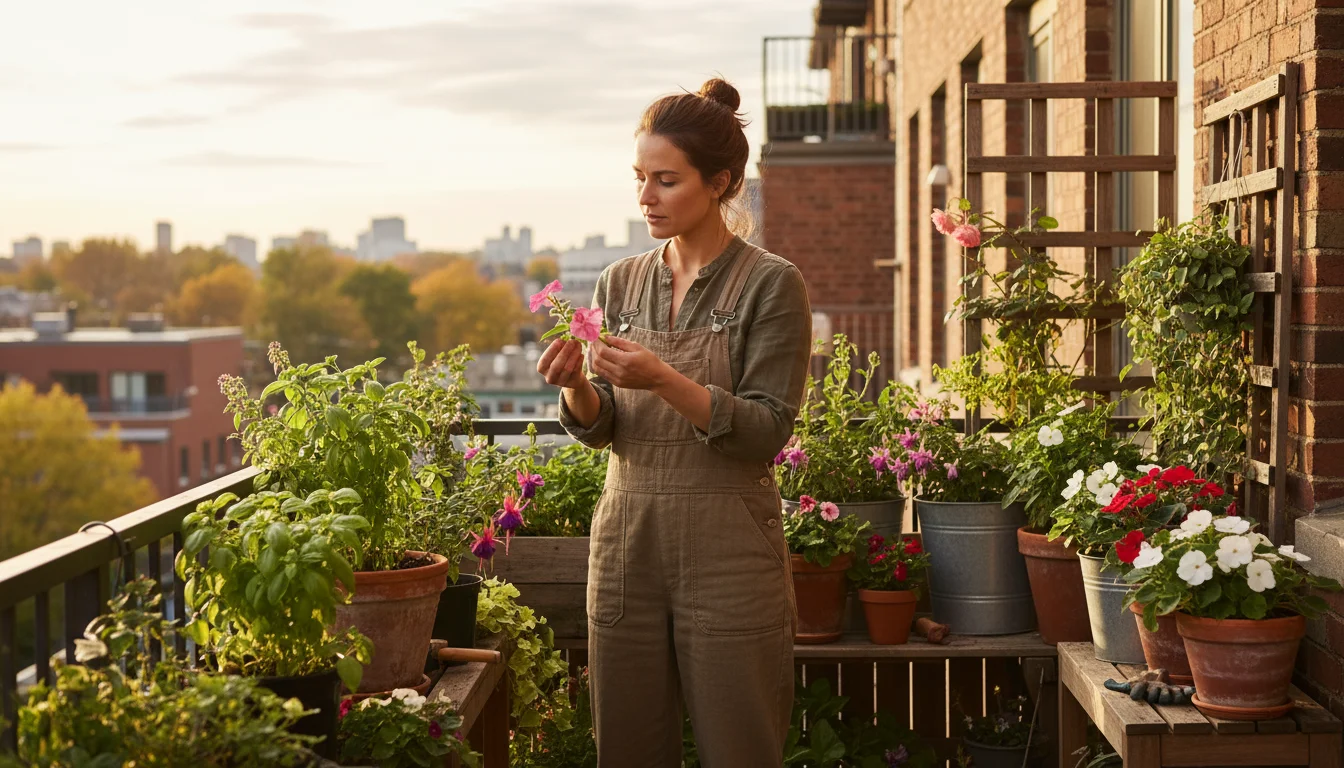
Identifying Your Vulnerable Balcony Plants
Not all plants react to cold temperatures in the same way. Knowing which of your balcony garden plants are most susceptible to frost damage allows you to prioritize your protection efforts. Broadly, plants fall into categories based on their hardiness.
- Tender Annuals: These plants complete their life cycle in one growing season and are highly sensitive to frost. Examples include impatiens, petunias, coleus, basil, tomatoes, peppers, and most common herbs like cilantro. Even a light frost can cause these plants to collapse.
- Tender Perennials: These plants can live for multiple years in warmer climates but cannot tolerate freezing temperatures. Common balcony examples include geraniums (pelargoniums), fuchsias, begonia, and tropical houseplants like philodendrons or ferns that you bring outside for summer. Their foliage will quickly succumb to frost, though some might regrow from protected roots if conditions improve quickly.
- Half-Hardy Plants: These tolerate a light frost but will suffer damage in a hard freeze. Pansies, violas, snapdragons, and some leafy greens like kale often fall into this category. They might survive the first light frost with some leaf damage but need protection as temperatures drop further.
- Hardy Plants: These plants are naturally adapted to cold temperatures and can withstand freezing. Many evergreen shrubs, perennials native to your climate, and certain herbs like rosemary or thyme can handle frost, especially when planted in the ground. However, even hardy plants in containers can become vulnerable. Their roots, as mentioned, lack the insulation of garden soil, meaning prolonged freezing temperatures can still damage them.
Check the plant tags or do a quick online search for any plant whose hardiness you are unsure about. Look for information on USDA Plant Hardiness Zones or similar local zone systems. This data provides a general guide, but remember, container plants on a balcony are always a bit more vulnerable than their in-ground counterparts, typically performing as if they are in a zone one or two levels colder. For example, if a plant is hardy to Zone 7, it might only reliably survive winter in a container if you are in Zone 8 or higher, or with significant protection.
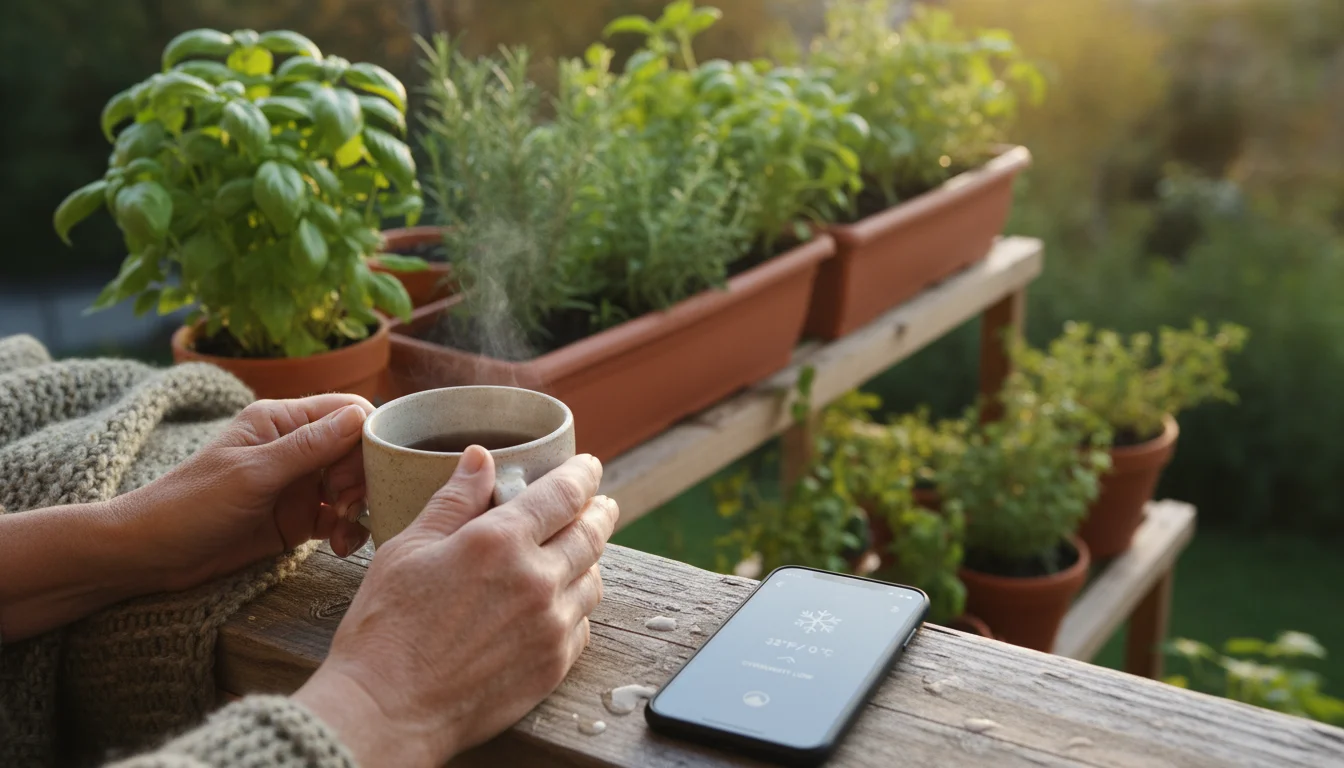
Timing is Everything: When to Act on Frost Warnings
Effective frost protection hinges on acting before the cold arrives, not after. A reactive approach often means your plants have already sustained damage. Your primary tool for timing your protection efforts is the local weather forecast.
- Monitor Local Forecasts Diligently: Begin checking weather forecasts daily as soon as autumn nights start getting cooler. Pay specific attention to overnight low temperatures. Many weather apps and websites offer hourly forecasts, which are incredibly helpful for tracking temperature drops.
- Understand “Frost Advisory” vs. “Freeze Warning”:
- A Frost Advisory typically means temperatures will drop to 33-36 degrees Fahrenheit (0.5-2.2 degrees Celsius), potentially leading to frost in low-lying or exposed areas. This is your cue to start preparing.
- A Freeze Warning indicates temperatures will reach 32 degrees Fahrenheit (0 degrees Celsius) or below for at least two hours, posing a significant threat to sensitive vegetation. This warning demands immediate action.
- Consider Your Balcony’s Microclimate: Even with a general forecast, your specific balcony conditions matter. A south-facing balcony sheltered by an overhang might stay warmer longer than an exposed north-facing one. Observe how quickly temperatures drop on your balcony on cool nights. Data from a simple outdoor thermometer placed on your balcony can give you a more accurate picture of your unique environment, often revealing temperatures a few degrees different from the generalized city forecast.
- Act Proactively, Not Reactively: Do not wait until the temperature has already dropped. The crucial time to implement frost protection strategies is in the late afternoon or early evening, before temperatures begin their significant descent after sunset. This allows you to apply covers or move plants before the cold stress begins. You want to cover plants when temperatures are still above freezing.
A good rule of thumb: when overnight temperatures consistently hover around 40 degrees Fahrenheit (4.4 degrees Celsius) or below, you should start planning and gathering your supplies for potential frost protection. The first fall frost can often be isolated, followed by a period of warmer weather, so you might need to uncover and recover plants multiple times. Stay flexible and prepared.
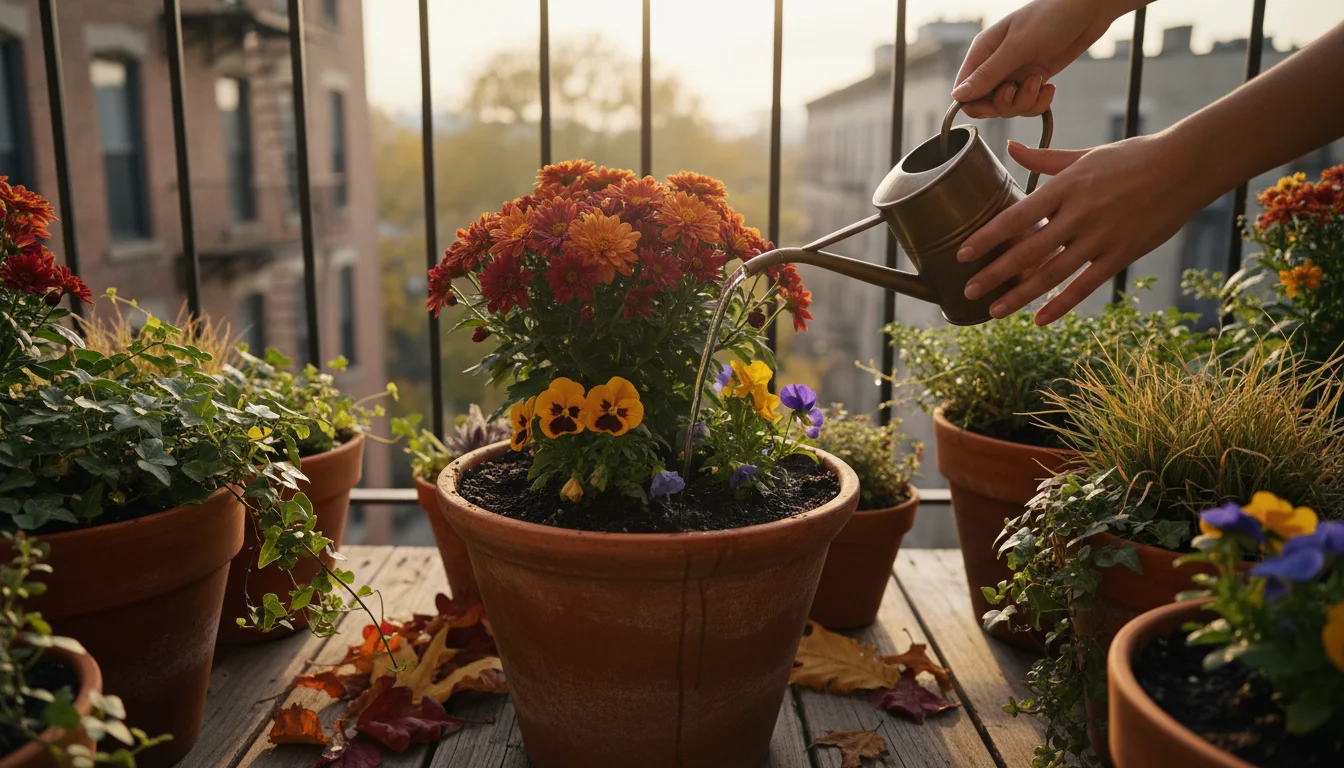
The Essential Frost Protection Checklist for Balcony Plants
Preparing your balcony garden for the first fall frost requires a systematic approach. This checklist outlines the key steps you should take to protect your container plants effectively.
- Hydrate Your Plants Thoroughly: Water your container plants deeply in the late afternoon on the day before a predicted frost. Moist soil retains heat better than dry soil, releasing it slowly overnight and providing critical warmth to the roots. Water also conducts heat more efficiently than air, helping to protect plant tissues. Avoid overhead watering that wets the foliage, as this can exacerbate frost damage if the water freezes on the leaves.
- Clear Away Debris: Remove any dead leaves, spent flowers, or garden debris from around your pots. This prevents fungal diseases and pest problems that can worsen when plants are stressed by cold. Cleanliness also ensures your protective covers fit snugly.
- Relocate Small, Tender Plants: Your smallest, most delicate annuals and tropical perennials are the easiest to move. Bring them indoors completely for the duration of the cold spell. Place them in a brightly lit room, away from cold drafts or direct heat sources. This is the most reliable method for sensitive species.
- Group Larger Pots Together: For plants that are too large to bring indoors, or those that are more tolerant but still need some help, group their containers closely together. This creates a small, communal microclimate where the plants share residual heat and shield each other from wind. Placing them against a warm wall of your building can add an extra layer of protection.
- Elevate Pots Off Cold Surfaces: If your pots sit directly on a cold concrete or metal balcony floor, elevate them using pot feet, bricks, or wooden blocks. This prevents direct heat transfer from the pot’s base to the cold surface, which rapidly cools the root zone. Even a small elevation can make a difference in insulating your container plants fall.
- Apply Mulch: For container plants that will remain outdoors, add a layer of organic mulch, such as straw, shredded leaves, or wood chips, to the top of the soil in each pot. A 2-3 inch layer insulates the roots, preventing rapid temperature fluctuations in the soil. This helps protect potted plants from first frost by keeping the root ball warmer.
- Prepare Protective Coverings: Gather appropriate materials for covering plants. This could include old sheets, blankets, burlap, or dedicated frost cloths (also known as row covers). Avoid using plastic sheeting directly on foliage, as it conducts cold, potentially causing more damage where it touches the plant. If you use plastic, ensure it does not touch the plant leaves.
- Support Covers Properly: When covering plants, create a mini “tent” structure to prevent the material from resting directly on the foliage. Use stakes, tomato cages, or even inverted laundry baskets to support your chosen covering. This ensures an insulating layer of air remains around the plant.
- Secure Coverings: Use clothespins, clamps, or weights to secure your covers to the pots or stakes. You want to prevent wind from blowing the covers off or allowing cold air to funnel underneath. An effective covering is one that stays in place.
- Monitor and Uncover: Remove coverings promptly once temperatures rise above freezing in the morning. Leaving plants covered during the day can cause them to overheat, depriving them of sunlight and potentially creating humid conditions ripe for fungal issues. Check the forecast regularly to determine if subsequent cold nights require re-covering.
Following this checklist helps you systematically approach frost protection, addressing the various ways cold can impact your balcony garden. This proactive approach ensures your plants remain healthy and vibrant for as long as possible.
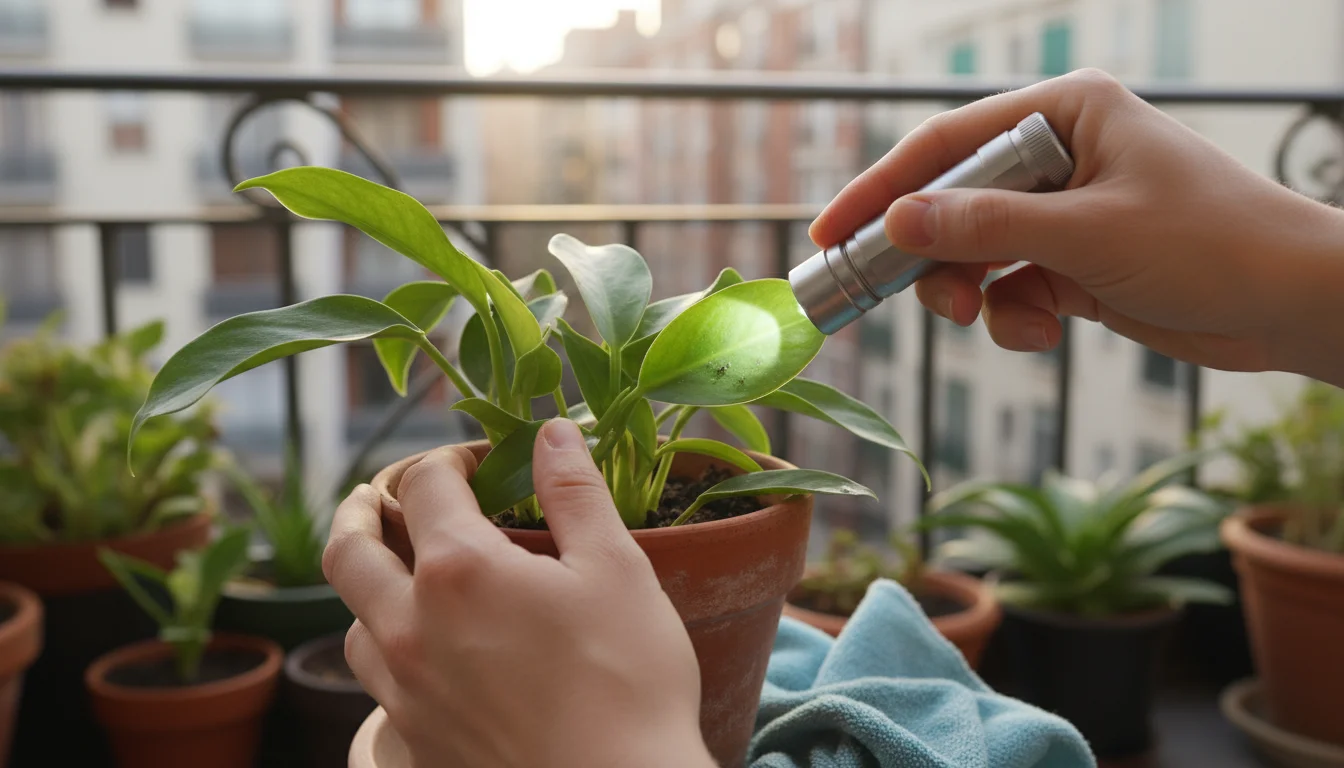
Relocating Your Plants: Bringing Them Indoors Safely
For many tender container plants, the safest and most effective frost protection is bringing them indoors. This strategy applies particularly to tropical houseplants you moved outside for summer, annuals you hope to overwinter, or delicate herbs. The transition from outdoor to indoor environments can stress plants, so careful preparation makes the process smoother.
- Inspect for Pests Thoroughly: Before bringing any plant indoors, meticulously inspect every leaf, stem, and the underside of the pot for pests. Common culprits include aphids, spider mites, whiteflies, and slugs. A small infestation outdoors can quickly escalate into a full-blown indoor pest problem. Use a flashlight for a close examination.
- Clean Your Plants: Wipe down leaves with a damp cloth to remove dust and any lingering pests. For plants with persistent pest issues, consider hosing them down gently outdoors or applying an insecticidal soap specifically formulated for plants. If you use insecticidal soap, do this a few days before bringing them in to allow time for the treatment to work and rinse off any residue.
- Prune as Needed: Trim back any leggy growth, dead leaves, or spent flowers. This reduces the overall plant mass, making it easier to manage indoors and minimizing potential hiding spots for pests. It also helps the plant focus its energy on new growth adapted to indoor conditions.
- Acclimate Gradually: The shock of moving from bright outdoor light to lower indoor light can cause leaf drop. If possible, transition plants gradually. Move them to a shadier spot on your balcony for a week before bringing them inside. Once indoors, place them in the brightest available window or under grow lights, away from drafts from doors or windows.
- Consider Repotting (Optional, but beneficial): If a plant is significantly root-bound, meaning its roots circle tightly around the pot, repotting it into a slightly larger container with fresh potting mix can reduce stress. Use a peat-free, well-draining potting mix. However, avoid repotting right before a hard frost if the plant is already stressed, as this adds another layer of change. In such cases, wait until spring.
- Maintain Proper Watering: Indoor plants typically require less frequent watering than outdoor plants due to lower light levels and less air circulation. Allow the top inch or two of soil to dry out before watering again. Using a moisture meter can provide accurate readings of soil moisture, preventing both overwatering and underwatering.
- Provide Adequate Humidity: Indoor heating systems often create dry environments, which can be detrimental to many plants, especially tropical varieties. Increase humidity by placing plants on pebble trays filled with water (ensure pots do not sit directly in the water), misting regularly, or using a small humidifier.
Bringing plants indoors is a commitment for the winter months. By taking these steps, you minimize stress and maximize the chances of your container plants surviving winter happily inside your home, ready to return to your balcony garden in spring.
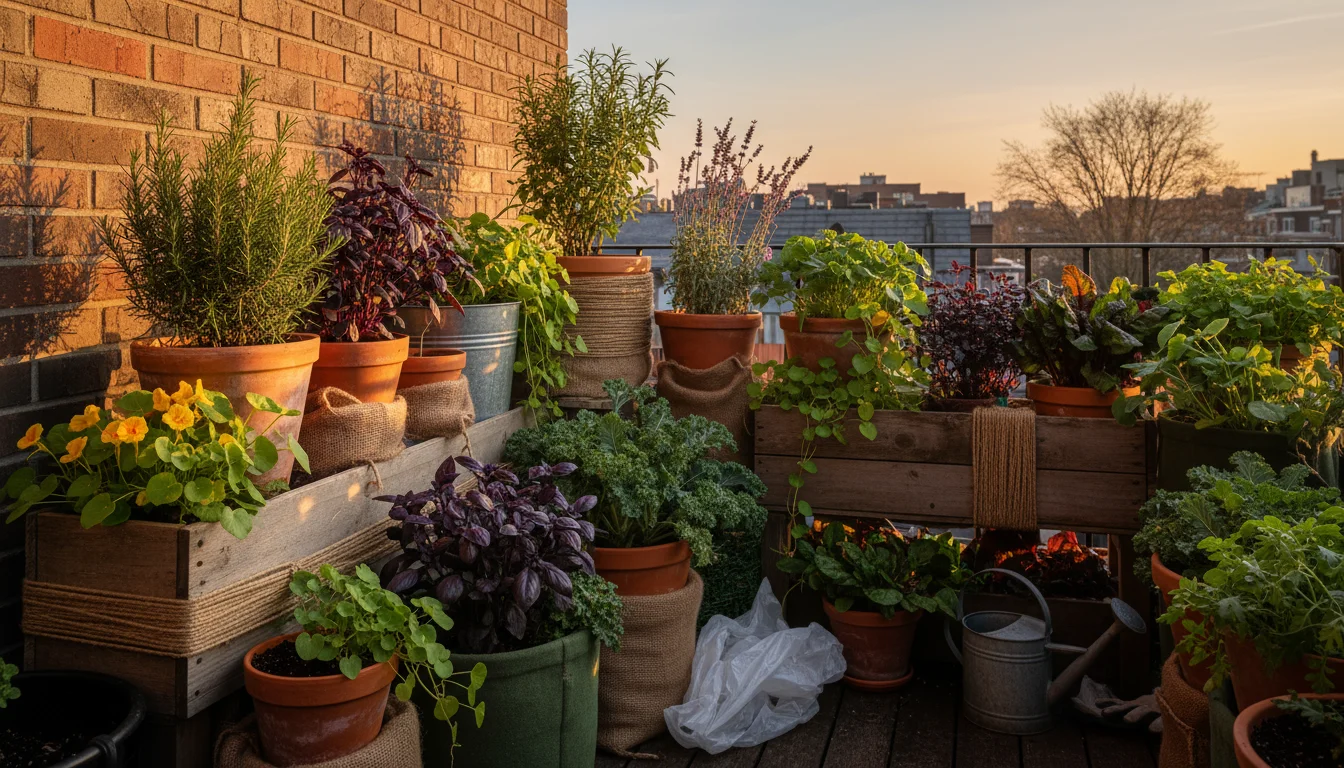
Outdoor Plant Protection Strategies for Balcony Gardens
Not all balcony plants can or should be brought indoors. Some are too large, or perhaps they are hardy enough to withstand mild cold but still need help with extreme temperatures. For these plants, effective outdoor frost protection is essential. These strategies aim to insulate plants, trap ground heat, and block cold winds.
- Grouping and Location:
- Cluster Pots: As mentioned in the checklist, grouping your pots tightly together is a simple yet effective strategy. This creates a collective mass that retains heat better than individual pots.
- Move Against a Wall: Position grouped pots against the warmest wall of your building, ideally one that receives some afternoon sun. Walls absorb solar radiation during the day and slowly release that stored heat overnight, offering a crucial buffer against falling temperatures.
- Corner Protection: Corners of a balcony or building provide extra shelter from wind, which exacerbates cold stress. A corner can act as a natural windbreak, reducing the chilling effect on your plants.
- Covering Plants with Appropriate Materials:
- Frost Blankets/Row Covers: These lightweight, breathable fabrics are designed specifically for plant protection. They allow light and some moisture to penetrate while trapping heat. You can buy these at garden centers. They are excellent for covering plants on a balcony for frost.
- Old Sheets or Blankets: Any thick fabric material like old bed sheets, burlap, or moving blankets can provide protection. The key is to ensure the material is breathable and does not hold moisture against the plant.
- Avoid Direct Plastic Contact: While plastic sheeting can block wind and some cold, it is not ideal for direct contact with foliage. Plastic conducts cold, and where it touches leaves, it can cause frost burn. If you must use plastic, ensure it is tented over the plants, creating an air pocket, and does not touch any plant parts. Secure it well, as plastic can easily tear in the wind.
- Creating a Protective Structure:
- Use Stakes or Cages: Insert stakes into pots or use tomato cages to create a framework over your plants. Drape your chosen covering material over this frame. This prevents the cover from flattening your plants and ensures an insulating layer of air remains around the foliage.
- Inverted Containers: For smaller plants, an inverted terracotta pot or a plastic storage bin can serve as a temporary cloche. Ensure the container is large enough not to crush the plant. These work best for short, quick frost events.
- Cardboard Boxes: Large cardboard boxes can also be used as temporary covers. They offer good insulation but can become soggy if wet, so only use them in dry conditions or for very short durations. Ensure they are removed in the morning to allow light and air circulation.
- Adding Insulation to Pots:
- Wrap Pots: For individual pots, especially those made of terracotta which cools rapidly, wrap the sides with burlap, bubble wrap, or old towels. Secure the wrapping with twine or tape. This extra layer of insulation helps protect the root ball from freezing.
- Pot-within-a-Pot: If you have larger, empty containers, consider placing a smaller potted plant inside a larger, empty one. Fill the space between the two pots with insulating material like straw, shredded leaves, or even crumpled newspaper. This technique significantly boosts root protection.
- Strategic Watering:
- Moist Soil, Not Wet Foliage: As previously mentioned, water deeply in the late afternoon before a frost. The latent heat released as water freezes (and its higher specific heat capacity) keeps the soil warmer than dry soil. Ensure you water the soil, not the leaves, to avoid ice formation on foliage.
Implementing these outdoor strategies maximizes the chances of your container plants surviving cold snaps. Remember to remove coverings during the day when temperatures are above freezing to prevent overheating and allow for air circulation and sunlight. Consistent monitoring of the weather forecast allows you to deploy and remove these protections as needed, effectively covering plants on a balcony for frost.
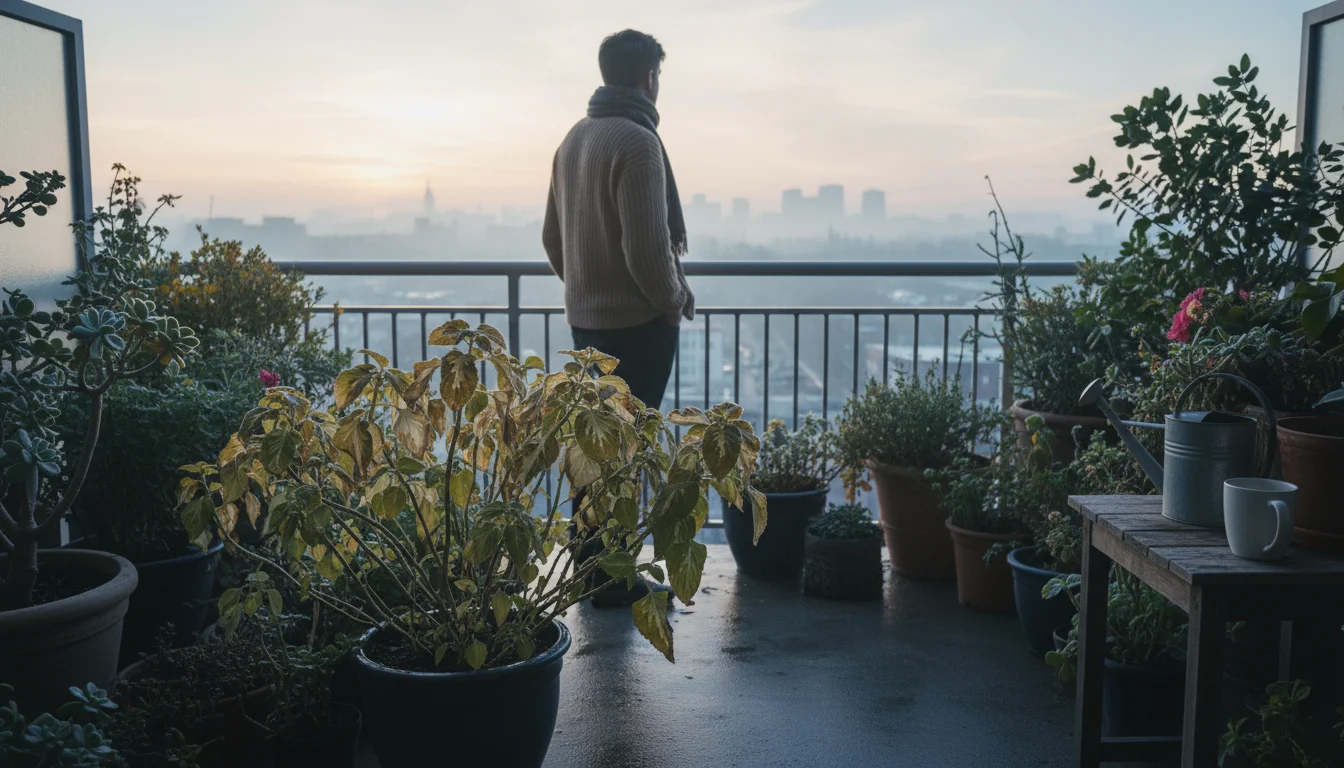
Post-Frost Care and Assessment for Your Balcony Plants
The morning after a frost, you might wake up to a potentially disheartening sight in your balcony garden. Do not panic. Taking the right steps immediately after a cold snap can sometimes salvage plants or at least help you understand the extent of the damage. Here is how to assess and care for your plants after the first fall frost.
- Do Not Immediately Prune Damaged Foliage: It is tempting to snip off all the blackened, wilted leaves right away. Resist this urge. Damaged foliage, while unsightly, can still offer some protection to the underlying stems and new growth if another frost is expected. Wait until the threat of frost has completely passed for the season before pruning.
- Assess the Damage Patiently: Give your plants a few days, or even a week, to fully reveal the extent of the frost damage. Sometimes, a plant looks terrible immediately after a frost, but the roots and lower stems remain viable. New growth might emerge from the base. Look for signs of life in the stems: scrape a small piece of bark on a woody stem. If it is green underneath, the stem is still alive. If it is brown or black, that section is likely dead.
- Provide Consistent, Moderate Watering: After a frost, plants can be stressed. Ensure the soil remains adequately moist, but do not overwater. Check the soil moisture regularly, and water when the top inch or two feels dry. Avoid fertilizing, as the plant needs to recover, not be pushed into new growth prematurely.
- Ensure Adequate Sunlight: If you moved plants indoors, ensure they receive sufficient light. If they stayed outdoors, uncover them once temperatures rise above freezing. Sunlight is crucial for photosynthesis and recovery.
- Pruning Dead Material (Later): Once you are certain the frost season has ended, or once a part of the plant is definitively dead and dry, you can begin pruning. Use clean, sharp pruning shears. Cut back to healthy, green tissue. This encourages new growth and improves the plant’s overall appearance and health. Dispose of dead material to prevent fungal issues.
- Consider Winterizing or Disposal: For annuals that have succumbed completely to frost, it is time to remove them from your containers. You can add them to your compost pile if they are disease-free. For tender perennials that show signs of life, you might still bring them indoors for the winter or protect them further if you intend to overwinter them outdoors in a protected spot.
- Reflect and Learn: Take notes on which plants survived, which did not, and which protection methods worked best for your specific balcony. This information is invaluable for next year’s frost preparations. Perhaps certain areas of your balcony are colder than others, or some plants consistently struggle. This reflective practice helps you adapt and refine your frost protection strategy for future seasons.
Post-frost care is a test of patience. By carefully assessing the damage and providing appropriate care, you can often help your plants recover or learn valuable lessons for future gardening seasons. Remember, every gardener experiences losses, but every loss also offers an opportunity for learning and growth.
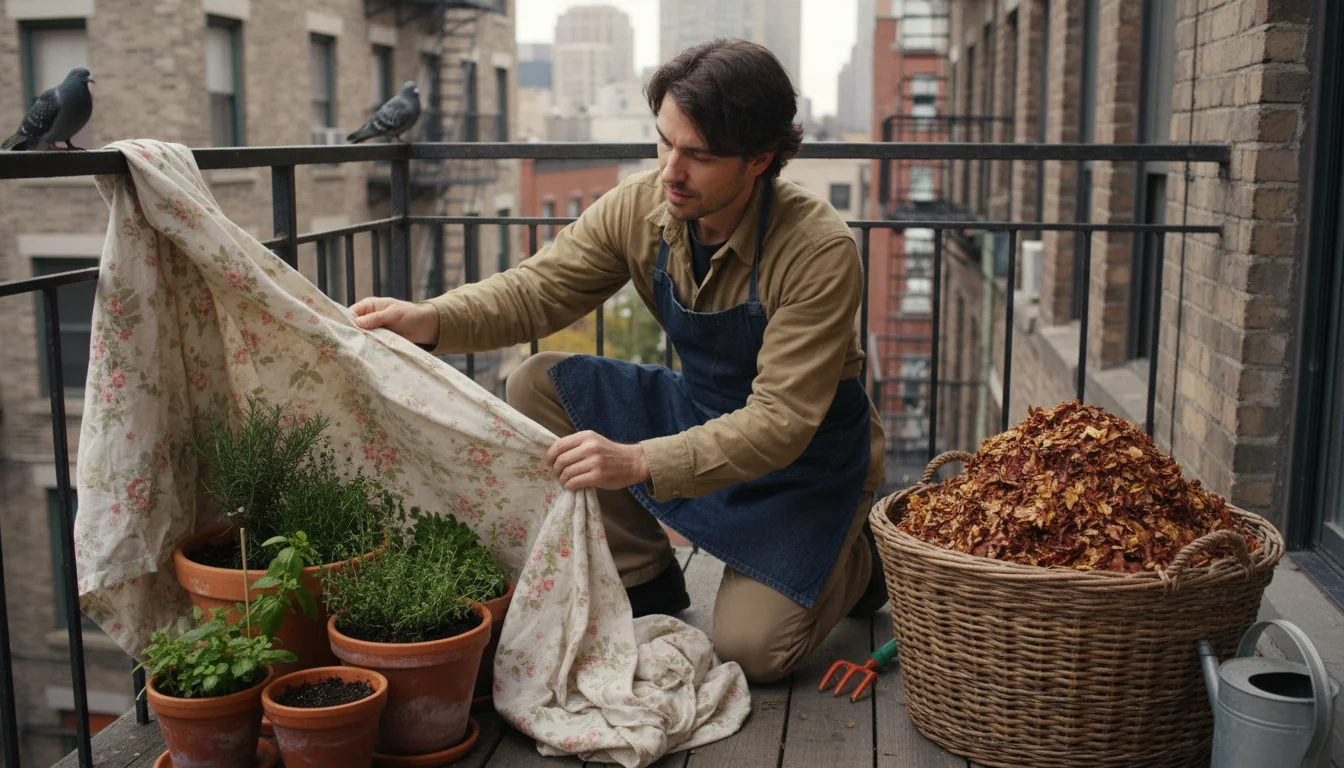
Sustainable Frost Protection Practices
At SimpleGardenJoy.com, we champion environmentally conscious gardening. Integrating sustainable practices into your frost protection strategy benefits both your plants and the planet. This means making choices that reduce waste, conserve resources, and minimize your ecological footprint.
- Reuse and Repurpose Materials:
- Instead of buying new frost covers every year, reuse old bed sheets, blankets, burlap sacks, or even large cardboard boxes. These materials work just as effectively as new products and prevent waste.
- Collect fallen leaves from your neighborhood to use as mulch in your pots. Shred them first to make them more effective and less prone to blowing away. This provides insulation and enriches the soil as they decompose.
- Consider creating simple DIY cloches from repurposed plastic milk jugs (bottom removed for ventilation) or clear plastic containers for smaller plants. Just remember the rule about not letting plastic touch foliage.
- Choose Perennials and Hardy Plants:
- Over time, shift your balcony plant selection towards hardy perennials and shrubs suitable for your climate zone. While container plants are always more vulnerable, choosing species inherently more tolerant of cold reduces your frost protection burden.
- When selecting annuals, opt for varieties known for their tolerance to cooler temperatures if you live in a region with unpredictable fall weather.
- Water Wisely:
- The practice of watering deeply before a frost is also water-wise. It provides essential insulation without requiring excessive, wasteful applications. Focus water directly on the soil to maximize absorption and minimize evaporation.
- Install a rain barrel on your balcony, if permitted, to collect rainwater. This free, chemical-free water source is excellent for your plants and reduces reliance on municipal water, especially during times of specific watering needs like pre-frost hydration.
- Prioritize Plant Health Year-Round:
- Healthy, vigorous plants are naturally more resilient to stress, including cold. Focus on providing consistent care throughout the growing season: proper watering, appropriate feeding with organic, slow-release fertilizers, and good pest management.
- Use peat-free potting mixes. Peat harvesting has environmental concerns, and many sustainable alternatives offer superior drainage and aeration, promoting stronger root systems that can better withstand environmental stresses.
- Compost Green Waste:
- After you prune frost-damaged plant material or remove spent annuals, compost them instead of sending them to a landfill. This turns organic waste into nutrient-rich soil amendment, closing the loop in your garden’s ecosystem. Ensure any diseased plant material is not composted to prevent spreading pathogens.
- Share Knowledge:
- Talk to fellow balcony gardeners about their frost protection strategies. Sharing practical tips and experiences within your community strengthens collective gardening efforts and promotes more sustainable practices.
Adopting sustainable frost protection methods not only protects your precious balcony garden but also aligns with a broader commitment to environmental stewardship. These small, thoughtful choices collectively contribute to a healthier planet and a more resilient garden.
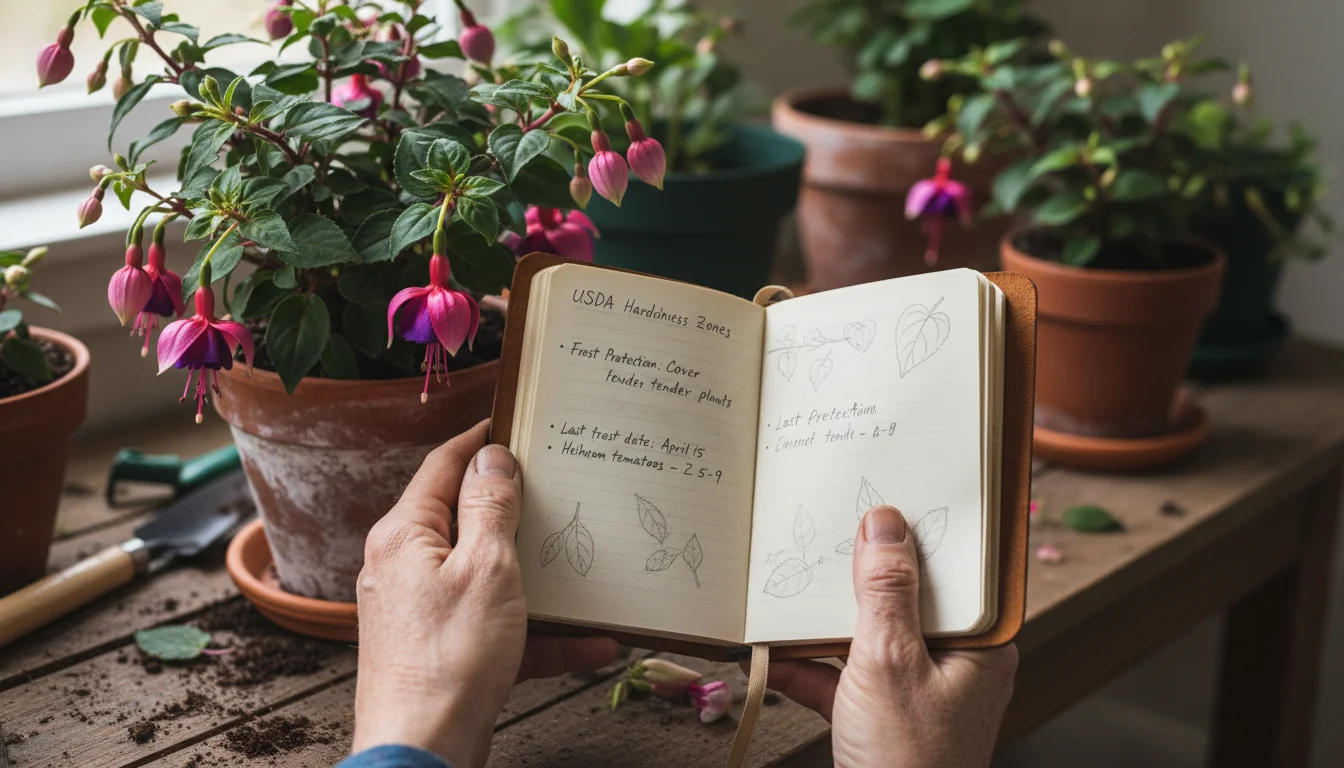
Frequently Asked Questions
What temperature is too cold for container plants?
Generally, temperatures at or below 35 degrees Fahrenheit (1.7 degrees Celsius) pose a risk to tender container plants, especially if sustained for several hours or if wind chill is a factor. While a light frost occurs at 32 degrees Fahrenheit (0 degrees Celsius), the roots in containers are more exposed and vulnerable to cold than those in the ground, so acting at slightly higher temperatures is wise.
How do I know if my plant is frost-damaged or just wilting?
Frost damage typically appears as blackened, water-soaked, or translucent foliage shortly after exposure. The affected leaves or stems might feel mushy or limp. Wilting from lack of water usually involves dry, drooping leaves that often perk up after a thorough watering, and they rarely turn black. If you suspect frost, wait a few days to see how the plant reacts before making a final assessment.
Can I use plastic garbage bags to cover my plants?
You can use plastic garbage bags as a last resort, but ensure they do not touch the plant’s foliage. Plastic conducts cold, and where it contacts leaves, it can cause more damage than protection. Use stakes or an inverted bucket to create a tent-like structure, so the plastic forms an insulating air pocket around the plant. Remember to remove plastic covers promptly in the morning as they can cause rapid overheating.
Should I fertilize my plants before a frost to make them stronger?
No, avoid fertilizing plants right before a frost. Fertilizers, especially those high in nitrogen, encourage tender new growth, which is extremely vulnerable to cold damage. You want plants to slow down their growth and harden off naturally as fall approaches. Stop fertilizing sensitive plants several weeks before the typical first frost date in your area.
What if I forget to cover my plants and a frost hits?
If your plants get hit by an unexpected frost, do not immediately prune the damaged parts. Wait until the full extent of the damage is clear, which might take several days. Damaged foliage can still offer some insulation if another cold snap is coming. Once the threat of frost has passed for the season, prune back only the definitively dead, blackened, or mushy parts to healthy tissue. Provide consistent, moderate watering and good light, and sometimes plants will surprise you by recovering from the root zone.
For research-based plant care guidance, visit
Iowa State University Extension — Yard & Garden,
Washington State University Hortsense,
University of Minnesota Extension and
Penn State Extension — Trees, Lawns and Landscapes.
Disclaimer: This article is for informational purposes only and is not a substitute for professional advice. Consult local extension services for region-specific recommendations.
